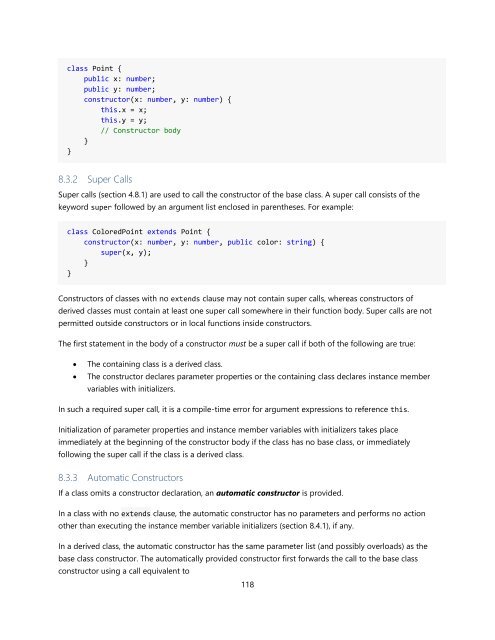TypeScript Language Specification v1.5
TypeScript Language Specification v1.5
TypeScript Language Specification v1.5
You also want an ePaper? Increase the reach of your titles
YUMPU automatically turns print PDFs into web optimized ePapers that Google loves.
class Point {<br />
public x: number;<br />
public y: number;<br />
constructor(x: number, y: number) {<br />
this.x = x;<br />
this.y = y;<br />
// Constructor body<br />
}<br />
}<br />
8.3.2 Super Calls<br />
Super calls (section 4.8.1) are used to call the constructor of the base class. A super call consists of the<br />
keyword super followed by an argument list enclosed in parentheses. For example:<br />
class ColoredPoint extends Point {<br />
constructor(x: number, y: number, public color: string) {<br />
super(x, y);<br />
}<br />
}<br />
Constructors of classes with no extends clause may not contain super calls, whereas constructors of<br />
derived classes must contain at least one super call somewhere in their function body. Super calls are not<br />
permitted outside constructors or in local functions inside constructors.<br />
The first statement in the body of a constructor must be a super call if both of the following are true:<br />
<br />
<br />
The containing class is a derived class.<br />
The constructor declares parameter properties or the containing class declares instance member<br />
variables with initializers.<br />
In such a required super call, it is a compile-time error for argument expressions to reference this.<br />
Initialization of parameter properties and instance member variables with initializers takes place<br />
immediately at the beginning of the constructor body if the class has no base class, or immediately<br />
following the super call if the class is a derived class.<br />
8.3.3 Automatic Constructors<br />
If a class omits a constructor declaration, an automatic constructor is provided.<br />
In a class with no extends clause, the automatic constructor has no parameters and performs no action<br />
other than executing the instance member variable initializers (section 8.4.1), if any.<br />
In a derived class, the automatic constructor has the same parameter list (and possibly overloads) as the<br />
base class constructor. The automatically provided constructor first forwards the call to the base class<br />
constructor using a call equivalent to<br />
118


















